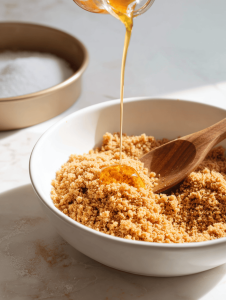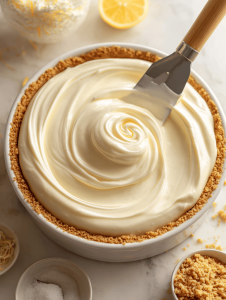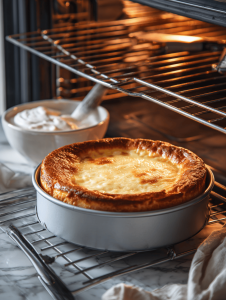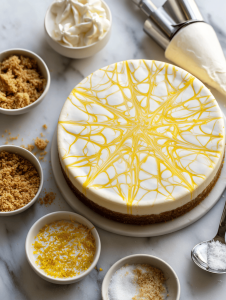I stumbled on this recipe while experimenting with unexpected flavor combos and textures. The idea of a cheesecake with a textured spiderweb swirl just clicked—something playful but still comforting. It’s a reminder that desserts can be both beautiful and a little bit chaotic, just like life sometimes. Plus, the tangy lemon twist cuts through the sweetness, making each bite lively.
Why this spiderweb cheesecake keeps calling me back
It’s the unexpected delight of creating a delicate web pattern. The tangy lemon keeps it lively, while the crunchy crust anchors the whole thing. Every time I make it, I remember how simple ingredients can turn into something visually stunning and delicious. It’s a little chaotic, a little messy—just like my kitchen, and I love that.
Breaking down the ingredients that make it magic
- Cream cheese: The creamy base that’s tangy and smooth. Use full-fat for richness.
- Graham crackers or digestives: Crushed for a crunchy, buttery crust—substitute with digestive biscuits if needed.
- Lemon zest and juice: Bright, zingy notes that cut through the richness—don’t skip zest for that aromatic punch.
- Sugar: Sweetens and balances the tang—powdered or granulated, your choice.
- Eggs: Bind everything together—room temp eggs blend more smoothly.
- Sour cream or heavy cream: Adds a slight tang and creaminess—use sour cream for extra zing.
- Butter: Melted to bind the crust—unsalted, unless you want a touch of saltiness.
Tools of the trade for a perfect spiderweb cheesecake
- Springform pan: To bake and easily release the cheesecake without damaging its delicate shape.
- Mixing bowls: For combining the crust ingredients and the filling.
- Electric mixer: To achieve a smooth, fluffy cream cheese mixture.
- Toothpick or skewer: To swirl the spiderweb pattern into the filling.
- Cooling rack: To cool the cheesecake evenly after baking.
Step-by-step to a mesmerizing spiderweb cheesecake
Step 1: Preheat your oven to 160°C (320°F).
Step 2: Mix crushed biscuits and melted butter; press into a 20cm (8-inch) springform pan.
Step 3: Bake the crust for 10 minutes until golden; set aside to cool.
Step 4: Beat softened cream cheese with sugar until smooth; add eggs one at a time.
Step 5: Fold in lemon zest and juice for that zesty punch.
Step 6: Pour filling over the cooled crust; swirl with a toothpick to create spiderweb patterns.
Step 7: Bake for 50-60 minutes, until the edges are set but the center jiggles slightly.
Step 8: Let the cheesecake cool in the oven with the door ajar for an hour.
Step 9: Chill in the fridge for at least 4 hours, preferably overnight.
Step 10: Before serving, create spiderweb designs on top with whipped cream or sour cream.
Cooking checkpoints to keep your spiderweb cheesecake perfect
- Ensure the crust is evenly pressed and baked until golden for a sturdy base.
- Watch the cheesecake edges; they should be lightly golden and slightly puffed.
- The center should jiggle like jello but not be liquid—use gentle nudges to test.
- Chill thoroughly; a well-rested cheesecake slices more cleanly and holds its shape.
Common pitfalls and how to dodge them
- Cream cheese is too cold, resulting in lumpy filling.? Use room temperature ingredients to avoid lumps in your batter.
- Oven temperature too high causing cracks and over-baking.? Bake at the right temperature; too hot and the top cracks.
- Not chilling long enough, leading to runny slices.? Chill thoroughly before slicing; a warm cheesecake will be messy.
- Over-mixing the pattern, losing the web look.? Use a toothpick to create the web; don’t over-swirl, or the pattern blurs.

Spiderweb Lemon Cheesecake
Ingredients
Equipment
Method
- Preheat your oven to 160°C (320°F). Mix the crushed graham crackers with melted butter until well combined, then press the mixture evenly into the bottom of a 20cm (8-inch) springform pan. Bake the crust for 10 minutes until fragrant and golden, then set aside to cool.

- In a large mixing bowl, use an electric mixer to beat the softened cream cheese and sugar until smooth and creamy, about 3-4 minutes. This creates a silky base for your cheesecake filling.

- Add the eggs one at a time, mixing gently after each addition to incorporate fully without overmixing. You should have a fluffy, well-blended batter.

- Gently fold in lemon zest and lemon juice using a spatula or a spoon, just until evenly distributed. The mixture will smell bright and citrusy, with a smooth texture.

- Pour the lemon filling over the cooled crust, smoothing the top with a spatula. Tap the pan lightly on the counter to settle the batter and remove any air bubbles.

- Use a toothpick or skewer to gently swirl patterns into the batter, creating a web-like spiderweb design on the surface. Be careful not to over-swirl, so the pattern remains distinct.

- Bake the cheesecake for 50-60 minutes, until the edges are set and slightly golden, but the center still jiggles gently when nudged. You’ll see a slight puff in the middle.
- Turn off the oven and leave the cheesecake inside with the door slightly ajar for about an hour to prevent cracks and help it cool gradually.
- Remove the cheesecake from the oven and cool completely on a cooling rack. Then, refrigerate for at least 4 hours or overnight to set fully.
- Before serving, optionally decorate the top with whipped cream or additional sour cream, and create more web-like patterns if desired. Slice carefully with a sharp knife for clean pieces.
Leave a Reply